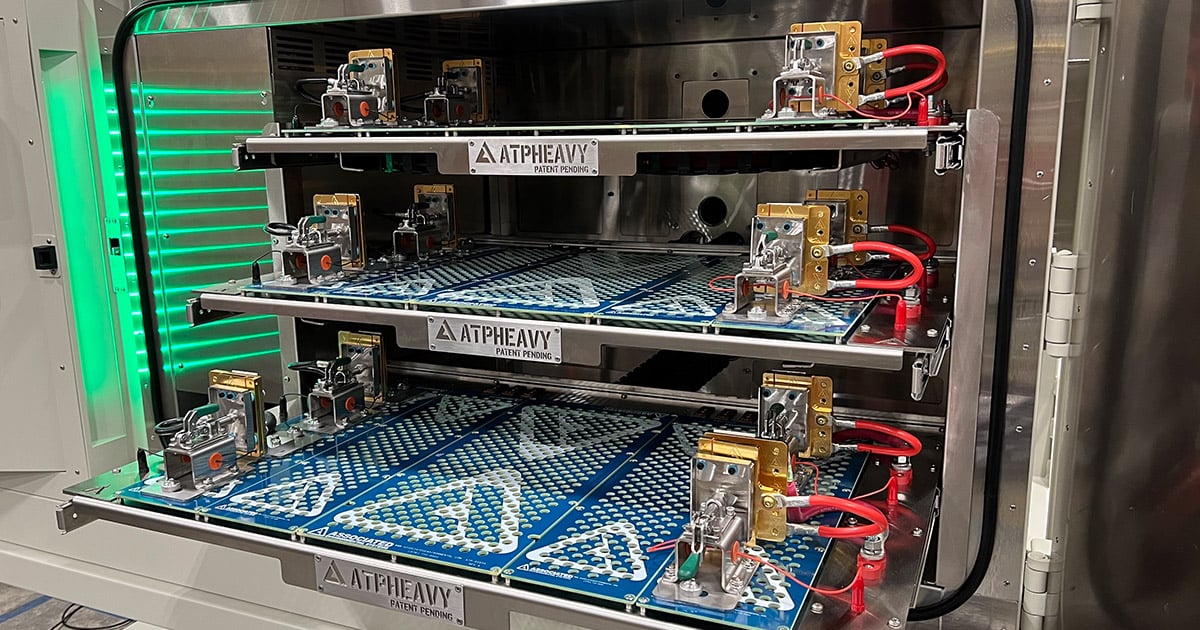Safety Features for Battery Test Chambers

Lithium-ion batteries have changed the world since they emerged commercially in the early 1990s. They’ve directly influenced the rise of portable handheld devices, while also opening the possibilities for electric vehicles (EVs), drones and military and defense uses, and led to renewable energy options.
As companies strive to produce longer-lasting, faster-charging batteries, they require equipment that enables them to conduct safe and efficient battery testing.
Battery test chambers must include features to promote the safety of users. Associated Environmental Systems developed AES SAFE for this purpose.
Battery Test Chamber Safety Features: AES SAFE & EUCAR Hazard Levels
Companies push the limits of their batteries during various types of battery testing, including performance and durability. As a result, battery test chambers need to sustain events without risking the safety of the users or the lab as a whole.
Building on EUCAR hazard levels, AES has introduced AES SAFE for its line of battery test chambers. AES SAFE chambers have the required safety measures to mitigate circumstances that could lead to a battery thermal event (BTE), so you can innovate with confidence and keep your lab and users' safety in mind.
For instance, if you’re testing to Severity Level 2—described as an irreversible defect or damage to a cell without leakage, flame, or rupture—set temperature limits, standard on AES chambers, are appropriate.
However, as you move to Severity Levels 3 through 7, you’ll need greater measures in place: burst disk, product thermocouples, safety purge, and optional gas sensors.
Here’s a breakdown of the features available:
Emergency StopThis button enables you to rapidly disrupt the entire function of the battery test chamber.
Set Point Temperature LimitA temperature control feature prevents a user from unintentionally setting temperatures beyond the established testing limits.
High/Low Temperature LimitOn a related note, this feature operates independently of the set point temperature limit, ensuring the control temperature limit doesn’t exceed what is safe for cells. For instance, AES’s ATP chambers do not exceed -20°C and 80°C.
Audible & Visual AlarmA loud sound is emitted when an emergency condition is at play, while visual cues reveal the current status of the chamber. A three-color system guides safe use: green indicates a chamber is ready for use and the door is unlocked, blue signals the chamber is in use and the door locked, and red announces the chamber is in alarm condition with the door locked.
Rapid Temperature ChangeSafety feature in place to monitor and detects when a rapid temperature shift occurs.
ReinforcementA reinforced stainless steel interior provides the durability necessary to conduct high-stakes battery testing.
Temperature Limited Sheath HeatersThe stainless steel, finned tubular heaters with a temperature sensor limit the maximum operating temperature of your battery test chamber.
Burst Disk/Low Flow VentMade from graphite, this burst disk contains rupture sensors that trigger your alarm system.
Door LockNot only should your chamber have a fail-safe rotary cam door to ensure it locks, but a mechanical override in case some electrical components malfunction. A cam position sensor indicates whether the door is locked. Most chambers will not function with an open or unlocked door.
Gas Sensors (Optional)These sensors monitor the chamber for combustible gasses.
Product SensorsInstalled on the rear of the chamber, these sensors enable you to monitor the products under test.
Safety PurgeWhen the test chamber is in an alarm state, this device triggers an inert gas purge.
Chamber Alarm InputWhen the external terminal block’s voltage signal is disrupted, this feature triggers an alarm state and the entire chamber shuts down.
Chamber Alarm OutputThis feature is intended to safely disable test equipment for a device under testing. While the chamber remains powered and in a safe state, the contact closes. However, a power loss or alarm condition opens the contacts.
Below outlines the recommended safety features for each severity level:
- Severity Level 1 (reversible loss of function) and Severity Level 2 (irreversible defect/damage) rely on the high/low temperature limit and set point temperature limit features.
- When reaching Severity Level 3 (leakage with mass change less than 50%) and Severity Level 4 (venting with mass change greater than 50%), you’ll need several more safety features: emergency stop, chamber alarm input, chamber alarm output, product sensors, reinforcement, safety purge, low flow burst disk, temperature limited sheath heaters, audible and visual alarms, and door lock.
- At Severity Level 5 (fire or flame), Severity Level 6 (Rupture), and Severity Level 7 (explosion), you get all the aforementioned features plus optional gas sensing features. Naturally, an expansive suite of safety features becomes more vital as battery testing becomes riskier as batteries are pushed to their limits.
Other Battery Testing Safety Considerations
As much as the safety features of a battery test chamber matter, they can be compromised by poor education and lack of maintenance. Users who employ the test chamber should be fully informed on everything from proper operations and installation to incident response. While human error can’t be eliminated, it can be minimized to avoid accidents.
For instance, a well-designed battery testing solution (such as AES’s ATP series, which includes ATPPRIME, ATPHEAVY, and ATPFLEX) limits waste as defined in lean manufacturing principles, maximizes efficiency, and is an easy test to set up—users can safely swap in battery cells without jeopardizing testing results.
Safety considerations are even more important when working with high-density or high-amperage batteries, due to their increased volatility and threat of thermal runaway events. Fortunately, advanced battery testing safety features give you peace of mind when working on the edge of the future, particularly the wide variety of batteries emerging in the automotive industry.
Working with lithium-ion batteries takes responsibility, and you’ll need to dedicate serious time and resources to conduct tests safely. The payoff, however, can change your industry, if not the world at large.
Associated Environmental Systems has a full line of test chambers that can be customized and fit with battery testing solutions for the purpose of testing lithium-ion batteries. Contact us to find out more today.


